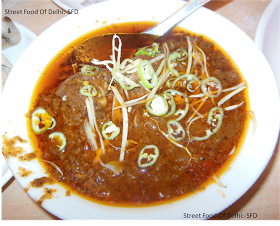Noor- The flickering light of lost recipes of the Mughals
Saira Mujtaba
Baat niklegi toh bahot dur talak jayegi… This couplet from the famous ghazal echoes in my head whenever I have a conversation on Mughlai food with someone. The city which was once an epitome of grandeur and royalty, the remnants of its magnificence are still seen in the astounding monuments dotting the city’s skyline. But Mughlai food being a very important part of the city’s royalty seems to have got influenced over time and one can’t really find the authentic taste and aroma that once emanated from the Royal kitchens of Shahjahanabad. Not only the taste of some popular dishes like qorma and biryani has got influenced by traces of other places (Moradabadi biryani being one such delicacy that has fused in the so-called Mughlai platter of Delhi), some of the dishes that were once served to the Royalty are now probably lost…or so I thought. This was the lament that I was living with until Fate made me acquainted with Mohammed Noor who traces his roots to the Royal chefs of Shah Jahan.
Nestled on the bustling road in front of Gate No. 1 of the grand Jama Masjid, Noor’s kitchen is a meek one room with a tandoor in one corner and 2-3 ‘chulhas’ with copper ‘degs’ sending out wafts of aroma into the air that tingle the tastebuds. The soot covered walls of the kitchen withholding so many secrets of lost Mughal recipes too.
 Noor stands out from the rest of the Mughlai cuisine chefs as he’s got the knack and art of preparing Mughlai food in his genes, for his forefathers served the Mughals seven generations ago and passed on this culinary magic to their progeny of which Noor is a flickering lamp in the city of glittery lights and glamour. Noor is the man behind the lost recipes of Mughlai kitchens. But in his own words, “ Mujhe English bolna nahi aati (I don’t know how to speak English language), and hence he feels that some big names who hog the limelight and organise food festivals in snazzy hotels exploit his talent and don’t give him much credit.
Noor stands out from the rest of the Mughlai cuisine chefs as he’s got the knack and art of preparing Mughlai food in his genes, for his forefathers served the Mughals seven generations ago and passed on this culinary magic to their progeny of which Noor is a flickering lamp in the city of glittery lights and glamour. Noor is the man behind the lost recipes of Mughlai kitchens. But in his own words, “ Mujhe English bolna nahi aati (I don’t know how to speak English language), and hence he feels that some big names who hog the limelight and organise food festivals in snazzy hotels exploit his talent and don’t give him much credit.
Noor considers Haji Kallan as his Ustaad. His ancestors used to work under Haji Kallan while serving the Royals and even today Noor is associated with Haji’s family as a part time cook.
Name any dish of the Mughlai cuisine and Noor knows it on fingertips. Ever heard of ‘gosht ka halwa’? Yes, I couldn’t believe that mutton could be served as a dessert as well, but Noor is adept in preparing all these unique dishes.
Kaancha Kofta, Mutanjan-Utanjan, Tumba Biryani, Mutton Barra, murgh musallam- bakra musallam and the list is endless. But it’s a travesty that people like Noor whose fingers possess the magic of preparing exquisite Mughlai foods, have to strive hard to make their presence felt. “Bade bade hotel mein ladke khaana pakaate hain par unke paas hunar nahi hai, sirf degree hai…mere paas hunar hai par degree nahi hai, isi liye main maat khaata hun (All these big hotels employ young boys who don’t have talent but they have degrees….I’ve got talent but don’t have a degree and that’s where I lag behind.)
Noor plans to pass on all the secrets of these lost recipes of Mughlai cuisine to one of his sons, but only time will tell if he will get his due in a world where degree sans true talent and refined English language overshadows real worth.












